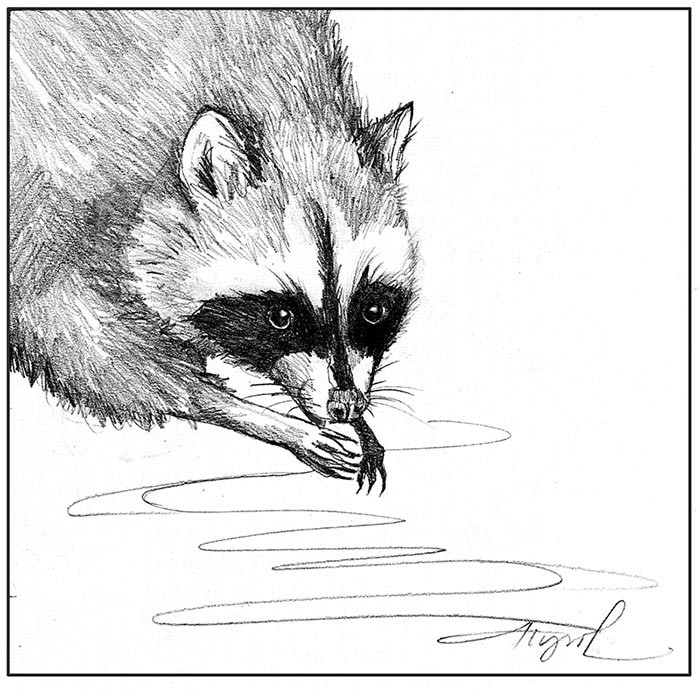
Almost every time I checked the game camera last summer – whether it was stationed near the compost, pointed into the field, or hidden at the edge of the woods – I found photos of one of our region’s most outwardly endearing creatures: the raccoon. With their black masks under perfect white eyebrows, their petite black noses, fuzzy ears, and fetchingly striped bushy tails, raccoons are certainly charming to look at. But that soft and cuddly exterior belies a fierce and highly intelligent disposition.
If curiosity killed the cat, it’s put more than one raccoon into a bind, too. When I was a little girl, a raccoon at a wildlife sanctuary reached long fingers from its enclosure and snagged the beaded hair tie right off the end of my braid. Among the things raccoons are curious about, apparently, is items that sparkle in the sun. Clever trappers have been known to catch a raccoon with a scrap of shiny aluminum foil as bait.
That inherent – and sometimes dangerous – curiosity is a sign of intelligence, said Dave Erler, senior naturalist at Squam Lakes Natural Science Center in Holderness, New Hampshire. This intelligence makes raccoons adept problem-solvers, and enables them to adapt to different habitats and food sources. They live just about anywhere they can find water, from forested areas and wetlands to agricultural landscapes and urban neighborhoods, where these nocturnal animals often get into trouble for raiding the chicken coop – or the trashcans left at the curb.
They will eat just about anything. Birds, eggs, small mammals, crayfish, fruit, carrion, and – yes – human garbage, gardens, and poultry are all on the menu. Although raccoons are known for “washing” their food, they’re really using their front paws to search for, examine, and dissect food before eating. They have highly developed nerves in their front paws, which become more sensitive when immersed in water.
The perceived washing habit plays into both the raccoon’s scientific and common names. “Raccoon” is from an Algonquin word “aroughcoune,” meaning “one who scratches with his hands.” The raccoon’s scientific name, Procyon lotor, breaks down to “dog-like” (although raccoons are scientifically more closely related to bears) and “washer.”
Beyond helping raccoons examine food and unlatch chicken coops and trashcans, their sensitive feet, with five long digits and sharp claws, also come in handy for climbing trees. Their modified ankle joints can turn out 180 degrees, allowing the animals to scamper down trees frontwards or backwards. Raccoons will climb and swim in streams while searching for food, but these skills also come in handy when they’re trying to evade danger.
“They are only average in their [swimming] ability,” said Erler. “But they will take readily to water if pursued and are very capable of drowning pursuers like dogs…by grabbing and holding the pursuer’s head under water.”
Now, as the days grow colder and darker, raccoons – like many wild animals – are busy eating as much as they can find and building up an extra layer of fat. Although they don’t hibernate, raccoons do hole up in dens during the bitterest days of winter and are able to sleep for long stretches of time – up to a month – without heading out into the elements. The extra layer of fat they add during the fall – about one-third of their total weight – helps provide insulation, along with a heavy coat of coarse fur. Raccoons, though typically solitary creatures, will sometimes den in groups during very cold weather.
Dens range from tree cavities and underground burrows to abandoned buildings and, sometimes, unused chimneys. And raccoons are not above kicking some other animal out of its warm den to take over.
“Raccoons are extremely powerful animals for their size (15-35 pounds), but are still able to squeeze into and through small openings. They are capable of displacing skunks and foxes from their dens if the situation warrants,” Erler said. “They’re smart enough to stay clear of larger predators as much as possible and avoid denning where they would be exposed to larger predators like coyotes.”
Cute and clever? Troublesome bandit? Whatever your perception of these curious critters, raccoons are so common throughout the region that chances are, they’re among your wild neighbors. I’ll be looking for their tracks through the snow around the forests and fields during warmer days this winter – and checking the game camera for glimpses of masked faces and ringed tails.


Discussion *